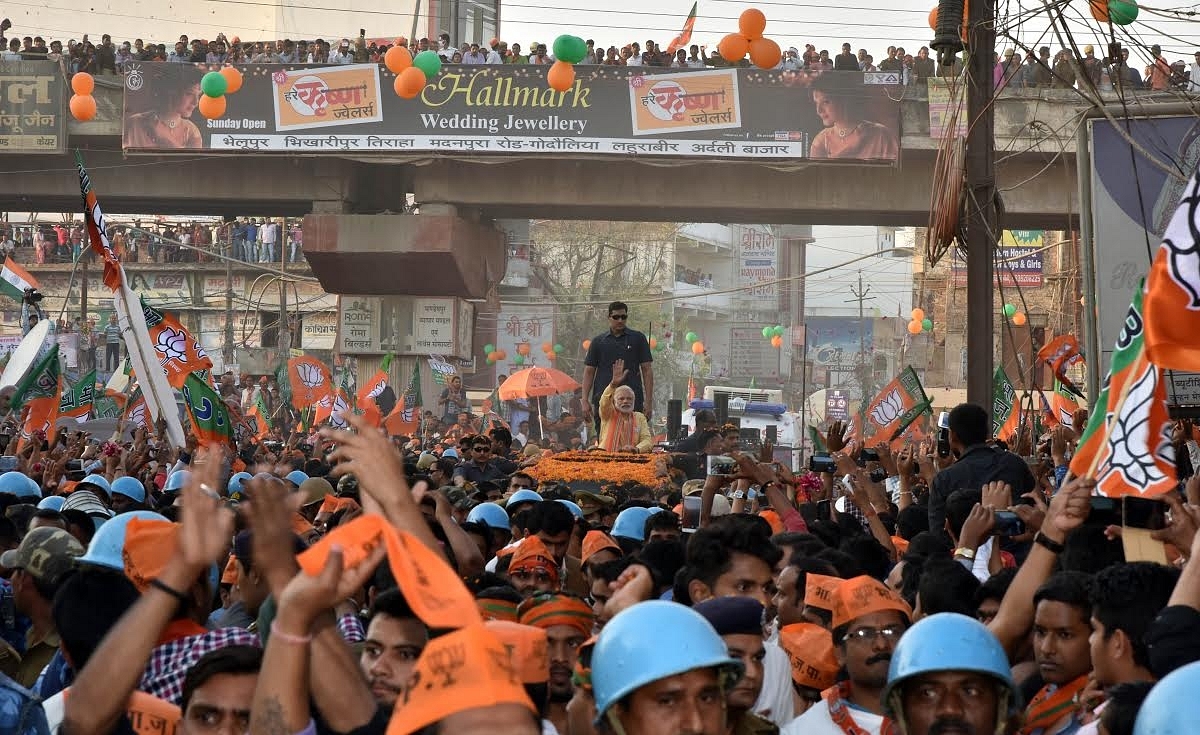Politics
Update From Epicentre: What Is Likely To Happen In The Seven Seats In Varanasi
- Out of the seven assembly seats in Varanasi, how many are likely to come to BJP after Narendra Modi’s camping in the city? Find out here.

Modi in Varanasi
In the 2014 Lok Sabha elections, the Bharatiya Janata Party (BJP) wiped out its opponents by winning 73 of the 80 parliamentary seats in Uttar Pradesh. In terms of assembly segments, the party led in 328 of the 403, about 81 per cent – a record. Only the Janata Party had won 80 per cent of the seats in the state after the Emergency backlash routed the Congress.
Layman’s logic would say that after the stupendous performance in 2014, the 2017 assembly elections should be a walk-over.
That a different dynamic works in the state polls was demonstrated in the by-polls held in September 2014, after 11 seats were vacated by the BJP legislators who were elected to the Lok Sabha. The BJP could retain only three seats while the Samajwadi Party (SP) wrested the remaining eight.
Among the seats lost by the BJP was Rohaniya in Prime Minister Narendra Modi’s parliamentary constituency of Varanasi. The seat was won by SP’s Mahendra Singh Patel, who has been re-nominated by his party. Union minister Anupriya Patel’s mother Krishna Patel was placed second. Krishna Patel is again a contestant, this time as an Independent.
In 2012, Apna Dal’s Anupriya Patel won from this constituency. The BJP won two other seats in the city – Varanasi South and Cantonment – and is now under tremendous pressure to excel.
Rohaniya puts into perspective the importance of Varanasi for the BJP and partly explains Modi’s three-day stay in the pilgrim city until before the campaigning ended on 6 March.
By-polls, some would argue, are not the real stuff. Yet, things don’t appear to be easy in Rohaniya this time because of the Congress-SP alliance and the presence of Krishna Patel as spoiler.
The factors that could swing the outcome in BJP’s favour, however, are the Prime Minister’s appeal, vis-a-vis that of chief minister Akhilesh Yadav and Bahujan Samaj Party (BSP) president Mayawati’s, and the hype built around currency note ban hitting the corrupt rich.
However, the thrust of Modi’s campaign was in Varanasi South, where the BJP dropped the sitting MLA Shyamdeo Roychaudhary ‘Dada’ and fielded Neelkanth Tiwari instead.
Although an angry Dada was cajoled into campaigning for Tiwari, the seven-time legislator played hard ball. Locals said that Roychaudhary’s supporters did not campaign for Tiwari, but chose to work for Rajesh Mishra (Congress) to make the fight tough for the newcomer.
The BJP looks vulnerable here as Mishra has the backing of SP votes. Only a split in Brahmin and Muslim votes in favour of the BSP would help the BJP sneak through.
From Varanasi Cantt, BJP’s Jyotsana Srivastava had won in 2012, defeating Anil Srivastava (Congress) by a margin of 12,852 votes. Backed by SP, Anil is again in the fray while the BJP has replaced its four-time MLA with Saurabh Srivastava. Rizwan Ahmad is the BSP candidate from here but the fight is between Congress and BJP.
With almost all the seats witnessing a triangular contest, voting percentage was also likely to play a role in the final outcome. The 63.7 per cent turnout in Varanasi South must have come as a relief to the BJP. Varanasi Cantt and City North constituencies recorded comparatively low poll percentages of 56.07 and 58.61, respectively, not a good sign for Team Modi. Even the RSS was reported to have voiced its concern at the low voter turnout which, it feared, would not be to the BJP’s advantage.
Significantly, the BJP is said to have made inroads in rural areas and was likely to make gains here. The party’s gains were likely in the Sevapuri, Shivpur and Pindra seats. Distribution of gas cylinders among the poor was going to fetch dividends for the party here, said a local journalist.
It would be naïve to conjecture on the Varanasi results without taking the Dalit and Other Backward Class (OBC) votes into account. In the Lok Sabha elections the BJP’s vote share was 42.30 per cent. This also included its ally Apna Dal’s vote share. The SP got 22 per cent votes and the BSP 19.60 per cent. The BSP was again set to lose its vote share to the BJP. The same would be true of OBC votes moving from SP to BJP.
That, in the final analysis, would see the BJP grabbing more than three seats in Varanasi, at the very least, despite the perceived scare.
Support Swarajya's 50 Ground Reports Project & Sponsor A Story
Every general election Swarajya does a 50 ground reports project.
Aimed only at serious readers and those who appreciate the nuances of political undercurrents, the project provides a sense of India's electoral landscape. As you know, these reports are produced after considerable investment of travel, time and effort on the ground.
This time too we've kicked off the project in style and have covered over 30 constituencies already. If you're someone who appreciates such work and have enjoyed our coverage please consider sponsoring a ground report for just Rs 2999 to Rs 19,999 - it goes a long way in helping us produce more quality reportage.
You can also back this project by becoming a subscriber for as little as Rs 999 - so do click on this links and choose a plan that suits you and back us.
Click below to contribute.
Latest